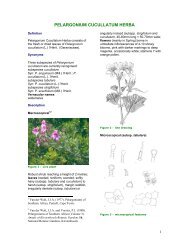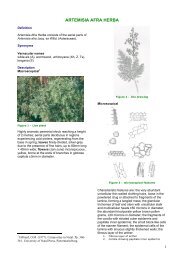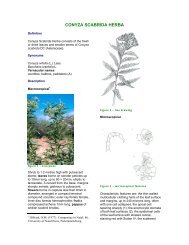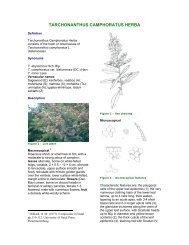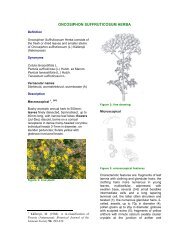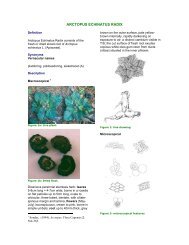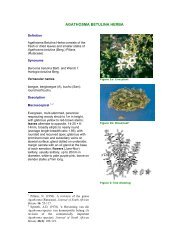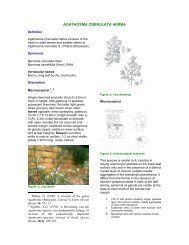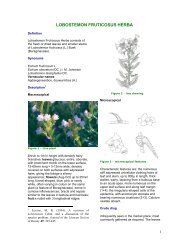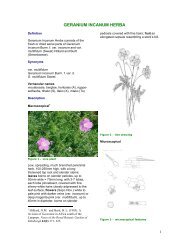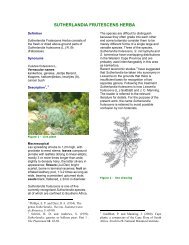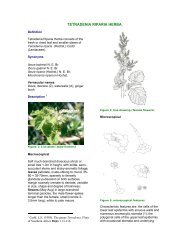CARPOBROTUS ACINACIFORMIS FOLIA - PlantZAfrica
CARPOBROTUS ACINACIFORMIS FOLIA - PlantZAfrica
CARPOBROTUS ACINACIFORMIS FOLIA - PlantZAfrica
You also want an ePaper? Increase the reach of your titles
YUMPU automatically turns print PDFs into web optimized ePapers that Google loves.
Definition<br />
Carpobrotus Acinaciformis Folia consists of<br />
the fresh or dried leaves of Carpobrotus<br />
acinaciformis L. (L. Bol.) (Aizoaceae).<br />
Synonyms<br />
Carpobrotus concavus L. Bolus<br />
Carpobrotus vanzijliae L. Bolus<br />
Vernacular names<br />
Elandvye, strand-vy, suurvy (A), t’gaukum,<br />
gouna, sour fig<br />
Description<br />
Macroscopical GR3<br />
Mat-like succulent perennial with trailing<br />
stems up to 1.8m long; leaves opposite, in<br />
pairs, partly united at the base, triangular in<br />
cross section, up to 90mm long and 15-<br />
20mm thick, curved, sabre-shaped; flowers<br />
(Aug-Oct) brilliant magenta-pink, borne<br />
singly at the end of a short stalk, 120mm in<br />
diameter; fruits fleshy, constricted at the<br />
base, becoming leathery on drying;<br />
receptacle globose to oblong.<br />
Figure1: colour plate of live plant<br />
Figure 2: line drawing<br />
<strong>CARPOBROTUS</strong> <strong>ACINACIFORMIS</strong> <strong>FOLIA</strong><br />
Microscopical<br />
Figure 3: microscopical features<br />
Characteristic features are: the epidermal<br />
cells of the leaf with thickened cuticularised<br />
walls and paracytic stomata (1+2); the<br />
calcium oxalate raphide bundles occurring in<br />
cells of the leaf epidermis and subepidermal<br />
layer (1); the red-brown tannin idioblasts of<br />
the epidermal layer (1) and central stele,<br />
arranged in two concentric rings (3).<br />
Crude drug<br />
Succulent dull green when fresh, drying to<br />
brittle pale green; taste sour and astringent.<br />
Geographical distribution<br />
Coastal loose sands and rocky outcrops of<br />
the Western Cape Province, from Saldanha<br />
Bay to the Cape Peninsula and eastwards to<br />
Mossel Bay. May cover large areas.<br />
Figure4: distribution map
Quality standards<br />
Identity tests<br />
Thin layer chromatography on silica gel<br />
using as solvent a mixture of toluene:diethyl<br />
ether:1.75M acetic acid (1:1:1). Reference<br />
compound cineole (0,1% in chloroform).<br />
Method according to Appendix 2a.<br />
Rf values of major compounds: cineole:<br />
(blue-purple)<br />
Note The method used for TLC and HPLC<br />
fingerprinting gave poor results for this<br />
species, possibly owing to the large<br />
amounts of tannin present. Tannin removal<br />
prior to TLC 1 , 2 has been shown to improve<br />
band separation.<br />
HPLC on C18 column, method according to<br />
Appendix 2b.<br />
Major compounds:<br />
Total ash: 25.9% (determined according to<br />
the BHP 1996 using 1.0g dried ground<br />
material)<br />
Purity tests<br />
Assay<br />
Not yet available<br />
Major chemical constituents<br />
Little is known of the secondary chemistry of<br />
this species. Citric and malic acids and their<br />
calcium salts have been recorded as<br />
present, as has the alkaloid mesembrine,<br />
which occurs in several genera of<br />
Aizoaceae. GR1<br />
Other South African Carpobrotus species<br />
have been shown to contain hydrolysable<br />
1 Van der Watt, E. and Pretorius, J.C. (2000).<br />
Purification and identification of active<br />
antibacterial components in Carpobrotus edulis<br />
(L.) L. Bol. Journal of Ethnopharmacology 76:<br />
87-91.<br />
2 Springfield, E.P., Amabeoku, G., Weitz, F.,<br />
Mabusela W. and Johnson, Q. (2003). An<br />
assessment of two Carpobrotus species extracts<br />
as potential antimicrobial agents. Phytomedicine<br />
10: 434-439.<br />
tannins, various flavonoids e.g, rutin and<br />
hyperoside, phytosterols and aromatic acids<br />
1, 2 .<br />
Figure 5: chemical constituents<br />
Dosage forms<br />
Fresh leaf juice is used externally as a<br />
mouthwash, gargle, lotion and antiseptic<br />
wash. Preparations of the fruit are taken<br />
internally, applied to the skin or used as a<br />
mouthwash/gargle.<br />
Medicinal uses<br />
Preparations of the fruit are taken orally for<br />
the treatment of tuberculosis and other<br />
pulmonary infections. Leaf juice is applied to<br />
sores or burn/scald wounds and used as a<br />
styptic. Preparations of leaf juice, taken<br />
orally, are said to be diuretic and to relieve<br />
dysentery. Preparations of both leaf and fruit<br />
are taken internally to treat heart conditions<br />
and used as a mouthwash or gargle for sore<br />
throat and sores in the mouth. GR1<br />
There is some evidence that C. acinaciforme<br />
is used interchangeably with other<br />
Carpobrotus species. 2<br />
Pharmacology/bioactivity<br />
Fresh leaf juice (freeze dried and<br />
reconstituted) showed antimicrobial activity<br />
against Staphylococcus aureus, in the<br />
concentrations used for disc assays in our<br />
laboratories. No activity was noted against<br />
Candida albicans Pseudomonas aeruginosa<br />
or Mycobacterium smegmatis.
Ethanol (70%) extracts of fresh leaf of Greek<br />
provenance, tested for in vitro<br />
antibacteriophage activity against<br />
bacteriophages MS2, PHI-X0174, T-7, T2,<br />
T4 and Type1, were found to be inactive in<br />
all cases 3 .<br />
There is no other information in the<br />
published literature concerning the<br />
bioactivity of this species.<br />
Other South African Carpobrotus species<br />
(C. muirii and C. quadrifidus) have however<br />
been shown to exhibit antimicrobial activity<br />
against Staphylococcus aureus and<br />
Mycobacterium smegmatis 2 .<br />
See also C.edulis<br />
Contraindications<br />
None known.<br />
Adverse reactions<br />
None recorded.<br />
Precautions<br />
No special precautions.<br />
Dosage<br />
To be determined.<br />
Copyright in this monograph resides with the authors, the South<br />
African National Biodiversity Institute, the South African Medical<br />
Research Council and the University of the Western Cape. It may<br />
not be reproduced in whole or in part without the written consent of<br />
the copyright holders.<br />
3 Verykokidou, E., Skaltsa, H., Couladis, M. and<br />
Delitheos, A. (1995). Antibacteriophage activity<br />
of some Greek plant extracts. International<br />
Journal of Pharmacognosy 33(4): 339-343.



